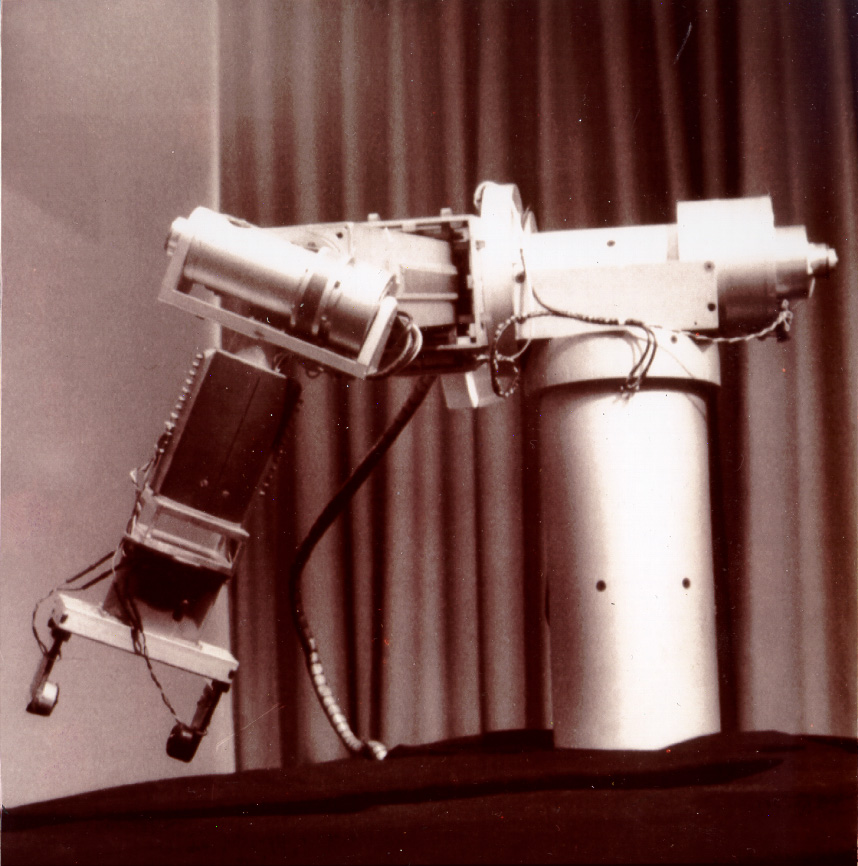 |
Large Robot picture (not yet)
 | |
| Photograph of Stanford Robot Arm [photo by Les Earnest] |
Stanford Robot arm (not yet on display)
The Stanford Arm, Victor Scheinman, Hand-Eye Project, Stanford Artificial Intelligence Laboratory, 1969.
The arm contains 6 joints, and was configured to approximate human reach, but with a different joint structure. A pair were mounted on a table and operated in concert with a camera, which scanned the table surface for objects, as blocks, which then could be stacked. Specified tasks were then accomplished without further camera feedback. The claw provided force feedback.
This robot arm was designed in 1969 by Victor Scheinman, a Mechanical Engineering student working in the Stanford Artificial Intelligence Lab (SAIL). This 6 degree of freedom (6-dof) all-electric mechanical manipulator was one of the first "robots" designed exclusively for computer control. Following experience with a couple of earlier manipulators, the Stanford-Rancho Arm (a modified prosthetic arm) and the Stanford Hydraulic Arm (a high speed but dangerous and difficult to control manipulator), this arm was designed to be easy to control and compatible with the existing computer systems (PDP-6) and the SAIL facility. This arm was entirely built on campus, primarily using shop facilities in the Chemistry Department.
The kinematic configuration of the arm is non-anthropomorphic (not humanoid) with 6 joints (5 revolute, 1 prismatic) and links configured such that the mathematical computations (arm solutions) were simplified to speed up computations. Brakes were used on all joints to hold the arm inposition while the computer computed the next trajectory or attended to other timeshared activities. Drives are DC electric motors, Harmonic Drive and spur gear reducers, potentiometers for position feedback, analog tachometers for velocity feedback and electromechanical brakes for locking joints. Slip clutches were also used to prevent drive damage in the event of a collision. Other enhancements include a servoed, proportional electric gripper with tactile sense contacts on the fingers, and a 6 axis force/torque sensor in the wrist.This robot arm was one of two mounted on a large table with computer interfaced video (vidicon) cameras and other special tools and tooling.The facility was used by students and researchers for over 20 years for Hand-Eye projects and for teaching purposes, as it was well characterized, reliable and easily maintained. Eventually it was replaced with commercial electric robots and newer Stanford designs. Some representative projects included assembly of a Model A Ford waterpump, partial assembly of a chain saw and solving Instant Insanity colored cube puzzles. These tasks all involved combinations of computer based modeling, planning, object recognition, vision, tactile and force sensing, collision avoidance, control and manipulation. Physical manipulation based tasks require close attention to issues of sequence, process, coordination, support, accuracy, contact and interference.The Stanford Arm and SAIL helped to develop the knowledge base
which has been applied in essentially all the industrial robots of
today.
courtesy of Stanford CSD Robotics group
 |
 |
 |

|

|